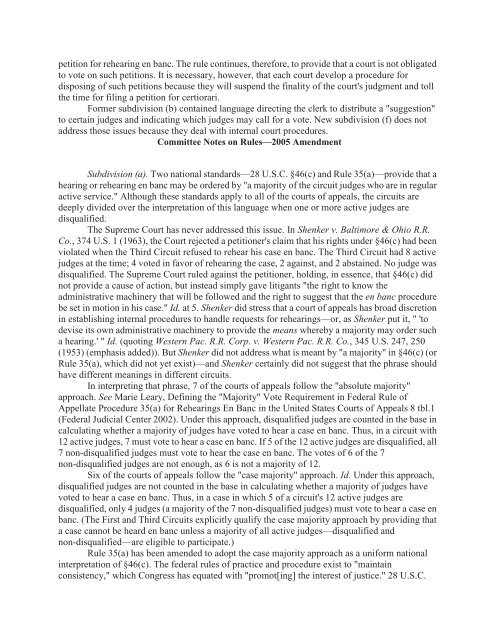Federal Rules of Appellate Procedure 2014-2015, 2014a
Federal Rules of Appellate Procedure 2014-2015, 2014a
Federal Rules of Appellate Procedure 2014-2015, 2014a
You also want an ePaper? Increase the reach of your titles
YUMPU automatically turns print PDFs into web optimized ePapers that Google loves.
petition for rehearing en banc. The rule continues, therefore, to provide that a court is not obligated<br />
to vote on such petitions. It is necessary, however, that each court develop a procedure for<br />
disposing <strong>of</strong> such petitions because they will suspend the finality <strong>of</strong> the court's judgment and toll<br />
the time for filing a petition for certiorari.<br />
Former subdivision (b) contained language directing the clerk to distribute a "suggestion"<br />
to certain judges and indicating which judges may call for a vote. New subdivision (f) does not<br />
address those issues because they deal with internal court procedures.<br />
Committee Notes on <strong>Rules</strong>—2005 Amendment<br />
Subdivision (a). Two national standards—28 U.S.C. §46(c) and Rule 35(a)—provide that a<br />
hearing or rehearing en banc may be ordered by "a majority <strong>of</strong> the circuit judges who are in regular<br />
active service." Although these standards apply to all <strong>of</strong> the courts <strong>of</strong> appeals, the circuits are<br />
deeply divided over the interpretation <strong>of</strong> this language when one or more active judges are<br />
disqualified.<br />
The Supreme Court has never addressed this issue. In Shenker v. Baltimore & Ohio R.R.<br />
Co., 374 U.S. 1 (1963), the Court rejected a petitioner's claim that his rights under §46(c) had been<br />
violated when the Third Circuit refused to rehear his case en banc. The Third Circuit had 8 active<br />
judges at the time; 4 voted in favor <strong>of</strong> rehearing the case, 2 against, and 2 abstained. No judge was<br />
disqualified. The Supreme Court ruled against the petitioner, holding, in essence, that §46(c) did<br />
not provide a cause <strong>of</strong> action, but instead simply gave litigants "the right to know the<br />
administrative machinery that will be followed and the right to suggest that the en banc procedure<br />
be set in motion in his case." Id. at 5. Shenker did stress that a court <strong>of</strong> appeals has broad discretion<br />
in establishing internal procedures to handle requests for rehearings—or, as Shenker put it, " 'to<br />
devise its own administrative machinery to provide the means whereby a majority may order such<br />
a hearing.' " Id. (quoting Western Pac. R.R. Corp. v. Western Pac. R.R. Co., 345 U.S. 247, 250<br />
(1953) (emphasis added)). But Shenker did not address what is meant by "a majority" in §46(c) (or<br />
Rule 35(a), which did not yet exist)—and Shenker certainly did not suggest that the phrase should<br />
have different meanings in different circuits.<br />
In interpreting that phrase, 7 <strong>of</strong> the courts <strong>of</strong> appeals follow the "absolute majority"<br />
approach. See Marie Leary, Defining the "Majority" Vote Requirement in <strong>Federal</strong> Rule <strong>of</strong><br />
<strong>Appellate</strong> <strong>Procedure</strong> 35(a) for Rehearings En Banc in the United States Courts <strong>of</strong> Appeals 8 tbl.1<br />
(<strong>Federal</strong> Judicial Center 2002). Under this approach, disqualified judges are counted in the base in<br />
calculating whether a majority <strong>of</strong> judges have voted to hear a case en banc. Thus, in a circuit with<br />
12 active judges, 7 must vote to hear a case en banc. If 5 <strong>of</strong> the 12 active judges are disqualified, all<br />
7 non-disqualified judges must vote to hear the case en banc. The votes <strong>of</strong> 6 <strong>of</strong> the 7<br />
non-disqualified judges are not enough, as 6 is not a majority <strong>of</strong> 12.<br />
Six <strong>of</strong> the courts <strong>of</strong> appeals follow the "case majority" approach. Id. Under this approach,<br />
disqualified judges are not counted in the base in calculating whether a majority <strong>of</strong> judges have<br />
voted to hear a case en banc. Thus, in a case in which 5 <strong>of</strong> a circuit's 12 active judges are<br />
disqualified, only 4 judges (a majority <strong>of</strong> the 7 non-disqualified judges) must vote to hear a case en<br />
banc. (The First and Third Circuits explicitly qualify the case majority approach by providing that<br />
a case cannot be heard en banc unless a majority <strong>of</strong> all active judges—disqualified and<br />
non-disqualified—are eligible to participate.)<br />
Rule 35(a) has been amended to adopt the case majority approach as a uniform national<br />
interpretation <strong>of</strong> §46(c). The federal rules <strong>of</strong> practice and procedure exist to "maintain<br />
consistency," which Congress has equated with "promot[ing] the interest <strong>of</strong> justice." 28 U.S.C.


















